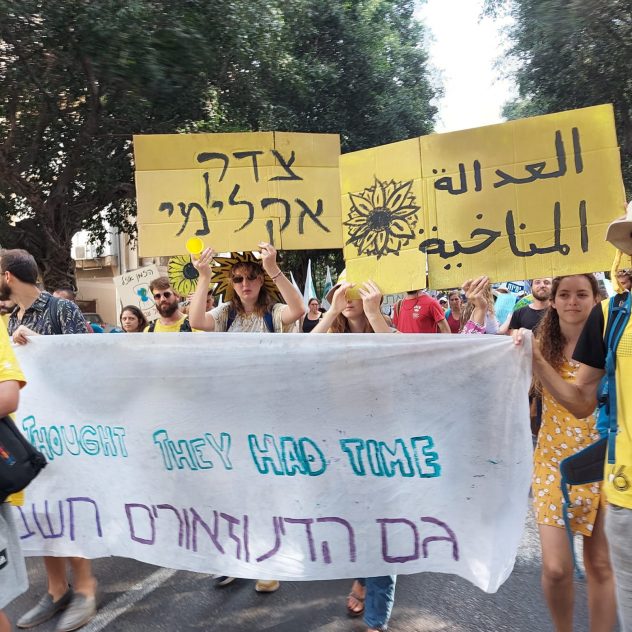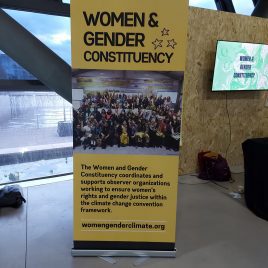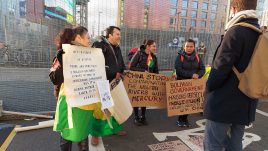
Arava Institute Executive Director Dr. Tareq Abu Hamed, and Deputy Director Eliza Mayo are attending the 2021 United Nations Climate Change Conference (COP26) in Glasgow as part of the official Israeli delegation. Dr. Clive Lipchin, Director of the Center for Transboundary Water Management, is also participating in the second week of the conference. Follow this post for regular updates and reflections from Eliza Mayo.
Wednesday, November 3rd
On Wednesday I traveled to Edinburgh for a meeting of women working in the renewable energy sector with Israel’s Minister of National Infrastructures, Energy and Water Resources Karine Elharrar. Elharrar made international news earlier during the week when the UN failed at first to accommodate her as a government minister needing to arrive in her wheel chair. Together with Israel’s ambassador to the United Kingdom, Amb. Tzipi Hotovely, Elharrar hosted an intimate meeting and networking opportunity to share ideas and thoughts about the energy sector in Israel, and discuss the COP meetings with us. I brought up issues of access to solar power in Area C of the West Bank, in Gaza, and in the Palestinian Authority.

After my morning meeting, I returned to the Blue Zone for a very interesting discussion of the Youth Environmental Alliance in Higher Education on catalyzing communities of future leaders: collaboration, research, and action. The panel began with the question: What are the most challenging barriers to student/youth optimism regarding climate change? How can we overcome these? Barriers discussed included the feeling that one person alone can’t produce change, and that it may be too late to make a change. Panelists felt that a solution-based approach could help, as well as, of course, real progress by government leaders at the COP meetings. “Getting Youth together in one place is so critical to building momentum and creating energy,” said one of the presenters at the panel. At the Arava Institute we know this to be true for our work too.
I ended my day partaking (once before leaving) in typical Scottish street food – fish and chips with pickled onions and a fizzy beverage called Irn Bru, which, as described to me by Scottish delegates to the conference, is most definitely “an acquired taste”.
Tuesday, November 2nd – People are the story
The story of being at COP26 would not be complete for me without talking about the people here. First of all, there are tens of thousands, a very odd and jarring experience after a year and a half of social distancing efforts during a pandemic. It took about an hour to enter the conference’s main area, the blue zone, on Tuesday morning. We were crowded into to a relatively small area, snaking slowly back and forth, a mosaic of people, all masked, some waiting patiently, some less, chatting in a multitude of languages into cellular devices. So chatting with random strangers while in queue for entry, for security, for lunch, is not a small part of the COP experience for me. It gives a tidbit into the life work of many different people who are with passion and concern acting for the world in a wide variety of ways, professions and approaches.

After speaking with Zandberg, Dr. Abu Hamed attended a session in the EU Pavillion on the Cypriot-led initiative for climate action in the Mediterranean, while I joined part of an interesting presentation on Egypt’s transition and net zero goals in their energy sector.


Sir David Attenborough addressed the world leaders late yesterday as a “people’s advocate” to the conference. His speech was broadcast on screens throughout the conference in both zone venue sites. He spoke beautifully about what governments need to do now to commit to change the course of the planet and humanity in a just way, stressing that cooperation is necessary to achieve this. “If working apart, we are a force powerful enough to destabilize our planet, surely working together, we are powerful enough to save it.”
Monday, November 1st

Judaism teaches that when you save a life, it as if you have saved the world. COP26 represents the hope that we will save the world in order to save lives and the planet. It’s a cliché but true.
The Arava Institute’s work centers on individuals and communities, locally and on a cross-border regional level. We maintain partnerships and connections in our immediate region of Israel –Palestine-Jordan, and with partners in the wider Middle East, the Mediterranean, and worldwide.
Partnership, connection, and cooperation are at the core of our work. So it felt appropriate to begin my COP26 experience at a brunch for Jewish delegates sponsored by the Board of Deputies of British Jews, Eco Synagogue, Commonwealth Jewish Council, and Glasgow Jewish Representative Council, at the Scottish Jewish Heritage Center at the beautiful historic Garnetthill Synagogue.
The Institute’s day-to-day work does not focus on the global macro-level. For me, that level gets confusing and feels remote. However, it is clear that we must maintain a view of and commitment to all the levels of action. Countries of the world must commit to “net zero” emissions to limit global warming to a 1.5 °C temperature rise by 2050; in doing so we must keep in our sight the individual humans, animals and plants that are at the highest risk. Our work in climate change adaptation and resilience in local off-grid communities matters as well. My personal moral commitment to these issues influences my approach to the topic on the micro-level within my life. In today’s complex interconnected world, we must hold and act on all of these in our lives and work.
Sunday, October 31st

As we are leaving today to Glasgow, we are hoping to expose the Arava Institute’s important transboundary environmental work, learn more in-depth about other approaches, and initiate new international partnerships in our mission to face the climate crisis.



